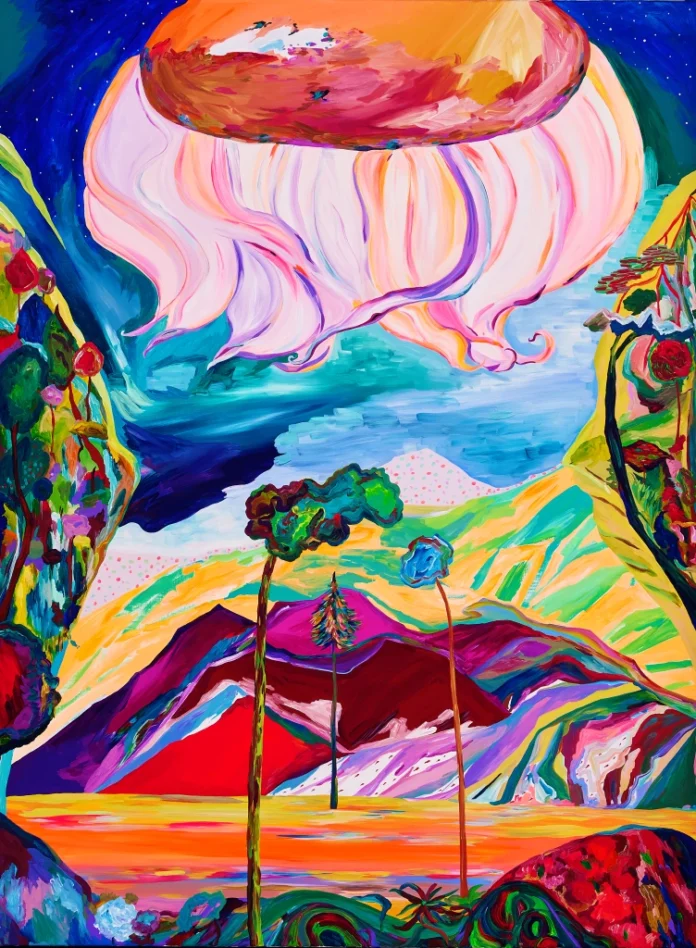In Moonflower, artist Özlem Thompson invites us into a mesmerizing world where imagination and memory entwine, and where vibrant colour becomes both emotion and atmosphere. Inspired by the luminous palette of Seville—one of Thompson’s favourite cities—this painting captures the enchantment of nature through a lens that is both poetic and personal.
A giant bloom floats above the landscape, part moon, part flower. It is a visual metaphor suspended between celestial and earthly realms. Below it, waves roll gently like silk, their deep blues and greens hinting at the mysteries of the ocean. The foreground pulses with warm, earthy tones—abstract trees and undulating mountains emerge from sun-drenched, orange-hued valleys. The resulting landscape is at once familiar and fantastical, a reflection of how emotion transforms perception.
Seville: The Spark Behind the Vision
Seville, with its orange blossoms, Moorish architecture, and endless sunlight, served as the catalyst for Moonflower. It is a city where colour feels amplified—terracotta rooftops, golden facades, and deep indigo shadows converge in a sensual, almost cinematic experience. Thompson channels these sensations not literally, but emotionally. Her interpretation distills Seville’s vibrancy into a palette that pulses with energy and tenderness.
As Thompson explains, “Seville fills me with colour. It’s like the light there dances through you. I wanted Moonflower to feel like that—like something glowing, something alive and timeless.”
A Language of Colour and Form
Colour is central to Thompson’s artistic vocabulary. In Moonflower, the interplay between glowing blues and burnt oranges creates an energetic push and pull—cool serenity contrasted with fiery warmth. These juxtapositions heighten the dreamlike quality of the composition, evoking both the calm of twilight and the surreal intensity of a dream just before waking.
Her forms are abstracted yet organic—rolling hills curve like waves, and tree shapes take on a rhythmic repetition that recalls cellular structures or botanical diagrams. This is no accident. With a background in Biology and Botany, Thompson often integrates natural patterns into her work. Her training brings an analytical precision to the whimsy, anchoring her dreamscapes in the subtle logics of the natural world.
Imagination Rooted in Nature
Thompson’s art consistently explores the tension—and harmony—between the imagined and the real. Though Moonflower may at first glance seem purely fantastical, its composition is grounded in close observation of the natural world. Her floating flower recalls the radial symmetry of night-blooming plants; the mountains echo Mediterranean landscapes scorched by summer sun; the sea, ever-shifting, reflects the mood and light of its surroundings.
This duality gives Moonflower its power. It is not merely an escape into fantasy but a poetic reconstruction of memory, science, and lived experience. Each element feels deliberate yet fluid, like a half-remembered place made vivid again through art.
A Mediterranean Soul with Global Reach
Özlem Thompson was born in Istanbul, a city where East meets West, tradition meets innovation. Since 2015, she has lived and worked in London, maintaining a studio in Belsize Park—the same neighbourhood where Piet Mondrian once created. Her artistic identity reflects this rich cultural layering. Influenced by Mediterranean heritage, classic cinema, and the textures of daily life, her work has a universal appeal that crosses borders and disciplines.
Her paintings have been exhibited in cities around the world—New York, Tokyo, Paris, Barcelona—and featured in respected publications like Capsules Book, Art Folio Annual, and House & Garden. Collectors such as Anita Dobson and Brian May have acquired her work, drawn to its joyful intensity and emotional resonance.
But Thompson’s reach is not limited to gallery walls. She created a public artwork for the Queen’s Platinum Jubilee and frequently supports causes close to her heart, including Elephant Family and Choose Love. Whether through community projects or personal canvases, her art reflects a deep commitment to beauty, empathy, and connection.
An Invitation to Dream
Moonflower is not just a painting—it’s an invitation. It asks viewers to slow down, to look closer, and to allow themselves to be transported. In an age of speed and distraction, Thompson offers something both nostalgic and necessary: the possibility of wonder.
There is a stillness in Moonflower, despite its vivid palette. The glowing flower overhead does not dominate but floats gently, as if illuminating the subconscious. The waves do not crash; they sway. The trees and mountains do not jut upward but rise softly, like thoughts drifting into shape. It is a painting that encourages contemplation and rewards repeated viewing.
Conclusion: The Art of Emotional Cartography
Through Moonflower, Özlem Thompson maps an inner landscape shaped by memory, nature, and colour. Her ability to blend scientific observation with artistic intuition results in a work that resonates far beyond the canvas. It captures not just the visual essence of a place, but its emotional gravity—the way a city like Seville can live in the heart, long after one has left its sunlit streets.
For those who stand before Moonflower, there is a sense of recognition—not of a specific location, but of a feeling: of warmth, wonder, and quiet awe.


